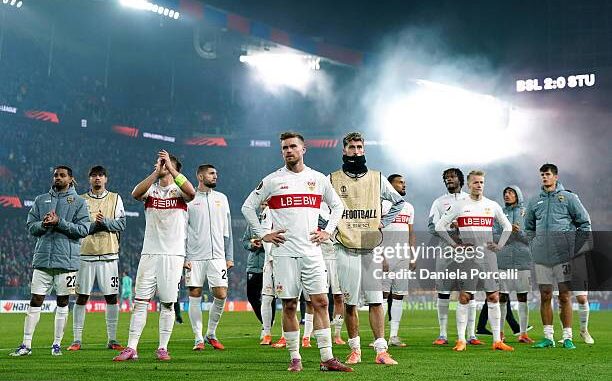
VfB Stuttgart’s trip to Switzerland ended in disappointment as they suffered a tough defeat against FC Basel — a result that exposed both tactical flaws and key lessons for Sebastian Hoeneß’s side. While it was only a friendly fixture, the performance provided valuable insights into Stuttgart’s readiness, squad depth, and tactical adaptability as they continue to prepare for the challenges ahead. Here are three key takeaways from the defeat in Basel.
—
1. Defensive Vulnerabilities Still Need Addressing
One of the most glaring issues in Stuttgart’s loss was their defensive instability. Basel exploited spaces behind Stuttgart’s high line with ease, particularly in transition. Time and again, Stuttgart’s backline struggled to cope with quick counterattacks and diagonal passes that split the defense.
Hoeneß’s system relies heavily on full-backs pushing high to support the attack, but this often left the center-backs exposed. The coordination between the midfield shield and the defensive unit was lacking, allowing Basel to find gaps that were punished clinically.
Even though the team has shown improvement in recent Bundesliga games, this friendly served as a reminder that defensive consistency remains a work in progress. The absence of experienced leaders like Waldemar Anton was felt, as younger defenders appeared hesitant in one-on-one duels. If Stuttgart are to sustain their ambitions for European qualification, tightening up defensively must be a priority.
—
2. Depth and Rotation Need Fine-Tuning
Hoeneß used the Basel game to rotate his squad and hand opportunities to fringe players. However, the performance revealed that some backup options are not yet ready to meet the club’s competitive standards. The midfield lacked cohesion without Enzo Millot’s creativity, while the attacking combinations were disjointed, resulting in a lack of cutting edge in the final third.
Stuttgart’s first-choice XI has been electric this season, but this defeat showed how much the team relies on certain key figures. The second unit struggled to maintain the same intensity and tactical discipline. Players like Leonidas Stergiou and Lilian Egloff showed flashes of quality, but the overall rhythm and tempo of Stuttgart’s play dropped significantly.
Hoeneß will undoubtedly use this match as a learning experience — a chance to identify which players can be trusted in rotation-heavy weeks. With a long season ahead, especially if European fixtures are added to the calendar, squad depth will be crucial to maintaining consistency.
—
3. A Reminder That Style Must Be Matched with Substance
Stuttgart’s possession-based approach was clear once again — patient buildup, quick interchanges, and aggressive pressing. Yet, despite dominating the ball for large stretches, they struggled to turn control into chances. Basel sat deep, absorbed pressure, and capitalized on Stuttgart’s mistakes — a tactic that many Bundesliga sides may replicate.
This game was a timely reminder that aesthetic football needs to be paired with ruthless execution. Efficiency in front of goal, sharper passing in the final third, and better decision-making under pressure are all areas that require refinement.
Hoeneß has crafted a system admired for its energy and technical precision, but Basel’s victory underscored the importance of balance — knowing when to take risks and when to maintain control.
—
Conclusion
While the defeat in Basel will sting, it offered Stuttgart valuable lessons at the right time. The match exposed defensive gaps, highlighted the need for improved squad depth, and emphasized the importance of turning possession into productivity.
As the season progresses, these lessons could prove invaluable. Stuttgart remain one of the Bundesliga’s most exciting teams — but to stay competitive, they’ll need to blend their flair wit
h greater resilience and tactical maturity.
Be the first to comment